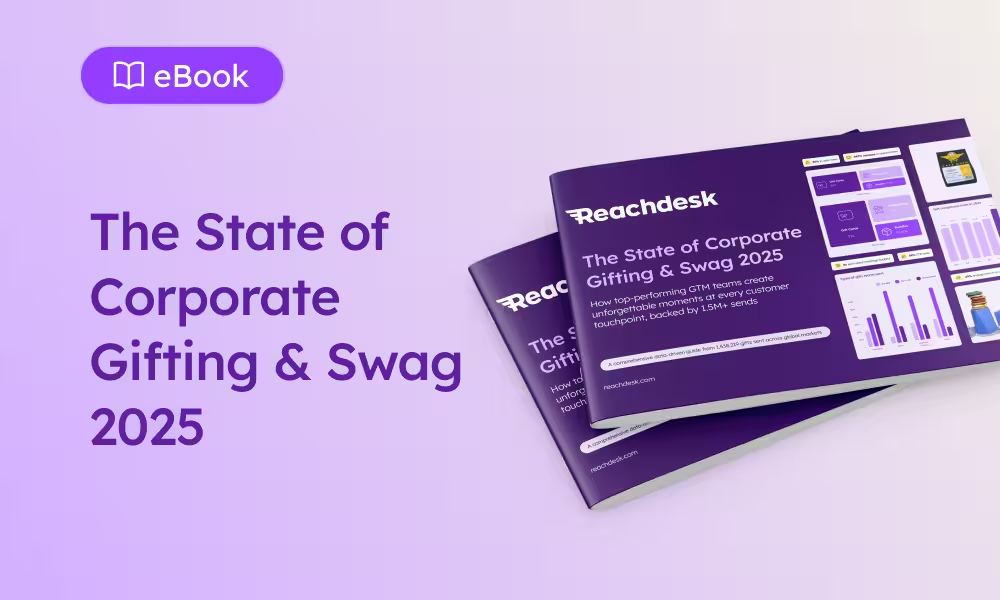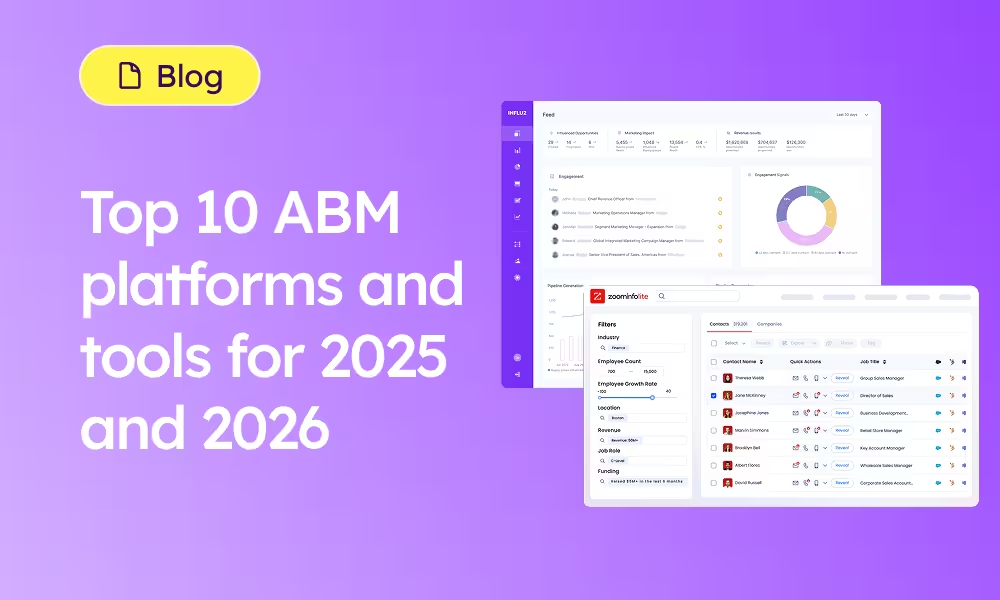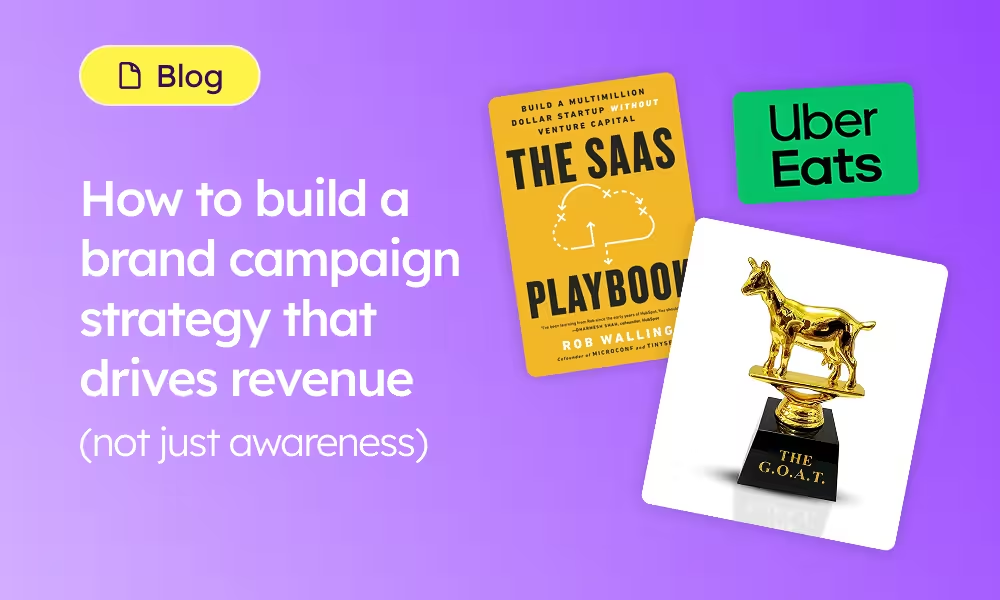One powerful platform for ROI-driven corporate gifting, swag, and engagement at scale.
Your pipeline is stalling. Your outreach emails disappear into inboxes that receive over 121 messages daily. Your sales team keeps asking for warmer leads, and your marketing budget feels like it's evaporating with nothing to show for it.
Sound familiar?
Here's the problem: you're treating all prospects the same when your best opportunities need targeted attention. Account-based marketing fixes this, but only if you build it right. And here's what most guides won't tell you: ABM without a meaningful way to break through gets you nowhere fast.
This guide walks you through building an ABM program from scratch, scaling it without losing the personal touch, and using corporate gifting as the engagement multiplier that turns cold accounts into active conversations.
What is account-based marketing and why your pipeline depends on it
Account-based marketing flips traditional B2B marketing on its head. Instead of casting a wide net and hoping for leads, you identify your dream accounts first, then build campaigns specifically for them.
Think of it this way: traditional marketing is like fishing with a net. ABM is spearfishing. You know exactly which fish you want, and you aim precisely.
Why ABM delivers better results:
- Your marketing budget goes toward accounts that actually match your ideal customer profile
- Sales and marketing finally work from the same playbook instead of pointing fingers
- You build real relationships with decision-makers instead of collecting anonymous clicks
- The ROI is measurable because you're tracking specific accounts, not vanity metrics
But here's where most ABM programs fail: they rely on the same tired channels everyone else uses. Your target accounts are getting hit with LinkedIn messages, cold emails, and generic content. They're numb to it.
Corporate gifting changes this equation. When you send a thoughtful gift at the right moment, you're not just another notification. You're a person who did something memorable. The data backs this up: gifted campaigns see 85.34% open rates compared to 39% for traditional emails, and conversion rates jump from 3% to 56.34%. That's not incremental improvement. That's a different game entirely.
How to start your ABM program: Five steps that set you up for success
Starting an ABM program without a clear plan is like building a house without a foundation. Here's how to build it right from day one.
Step 1: Identify your target accounts (and be ruthlessly selective)
Start by answering this question: if you could only work with 25 companies this year, which ones would transform your business?
Look at:
- Revenue potential: What's the lifetime value of these accounts?
- Fit score: Do they match your ideal customer profile?
- Intent signals: Are they actively looking for solutions like yours?
- Relationship potential: Do you have any existing connections or warm introductions?
Create a tiered list: Tier 1 (top 10-25 accounts), Tier 2 (next 50-75 accounts), and Tier 3 (next 100-150 accounts). Start with Tier 1. Master that before expanding.
Do this by exporting your CRM data and scoring accounts based on company size, industry, tech stack, and recent funding or growth signals. Use tools like LinkedIn Sales Navigator to identify accounts showing buying signals.
Step 2: Get sales and marketing on the same page (no, really)
The biggest ABM killer isn't bad strategy. It's teams that don't talk to each other.
Here's what alignment actually looks like:
- Shared account lists: Marketing and sales agree on which accounts to target
- Common KPIs: You both measure pipeline influenced, meetings booked, and deal velocity
- Regular syncs: Weekly 15-minute check-ins about account progress and intel
- Unified messaging: Sales knows what marketing is sending, marketing knows what sales is saying
The best unified teams create a shared Slack channel or Teams workspace for each Tier 1 account. Share intelligence, coordinate outreach timing, and celebrate wins together.
Step 3: Map your account engagement strategy
For each target account, you need to know:
- Who are the decision-makers and influencers?
- What challenges are they facing that you can solve?
- What content, messages, or offers would resonate with them?
- What channels do they actually use?
Build an account plan that answers these questions. This isn't a 40-page document. A simple one-pager, or slide deck with key contacts, pain points, and your 90-day engagement plan works better than an elaborate deck nobody reads.
Top tip: Use LinkedIn or ABM-focused intent data solutions like 6sense, Demandbase, Influ2, and ZoomInfo to research your target contacts. What do they post about? What groups are they in? What content do they engage with? This intelligence shapes your messaging and gifting approach.
Step 4: Launch multi-channel outreach (with gifting as your secret weapon)
Your target accounts aren't sitting around waiting for your email. They're buried in noise. You need to show up where they are, consistently and memorably.
Your channel mix should include:
- Personalized email sequences: Not templates blasted to thousands, but messages written for specific people at specific companies
- LinkedIn engagement: Comment on their posts, share relevant content, send connection requests with context
- Content tailored to their challenges: Case studies from their industry, whitepapers addressing their pain points
- Strategic gifting: Thoughtful gifts that start conversations
Here's where gifting becomes your unfair advantage. A $30 coffee bundle sent to a CMO before your pitch meeting increases demo attendance by 18%. A personalized book sent to a VP of Sales after your first call keeps you top of mind when they're ready to decide.
Step 5: Integrate gifting into your ABM campaigns
Gifting isn't a standalone tactic. It works best when woven into your broader campaign strategy.
Campaign integration ideas:
- Cold outreach: Send a gift with your first touchpoint to cut through inbox clutter. "I'm sending you a coffee voucher because I'd love five minutes to discuss how [company] is tackling [specific challenge]."
- Event follow-up: Send a gift to no-shows with a recording of the session and a note: "Sorry we missed you at our event. Here's what you missed, plus something to enjoy while you catch up."
- Milestone moments: Send gifts when accounts hit company milestones (funding rounds, new hires, product launches) to show you're paying attention.
- Re-engagement campaigns: Win back cold accounts with a thoughtful gift and a fresh angle on your value proposition.
Start simple. Pick one campaign, add gifting to it, and measure the results. Once you see the impact, expand to other campaigns. There’s no need to do it all at once, especially when global gifting platforms like Reachdesk make it easy to scale. With seamless CRM and ABM intent integrations, you can plan and automate personalized gifts at the perfect moments in your account journey.
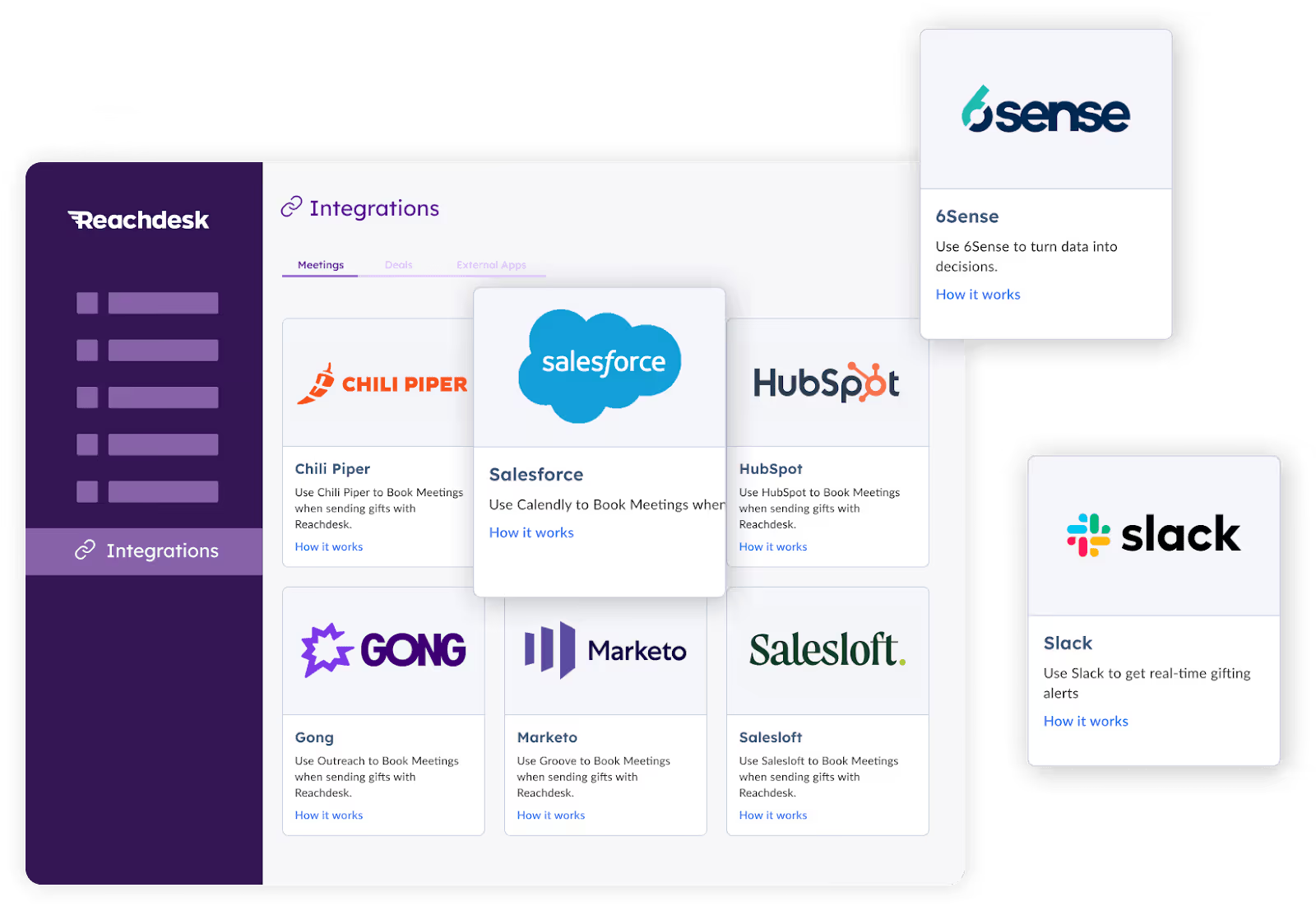
Want to learn how ABM leaders at Demandbase, Mural, 6sense, and others run successful programs?
Download our guide to discover their strategies and secrets for ABM success.
How to scale your ABM program without losing what makes it work
You've nailed ABM with your Tier 1 accounts. Meetings are booking, pipeline is growing, and your sales team is finally sending you thank-you notes instead of complaints. Now what?
Scaling ABM is where most programs fall apart. You can't just 10x your account list and expect the same results. Here's how to grow without diluting your impact.
1. Expand your account lists strategically
Don't just add accounts because you have budget left. Expand based on what's working.
Look at your Tier 1 accounts and ask:
- What do our best-performing accounts have in common?
- Which industries or company sizes convert fastest?
- Where are we seeing the highest engagement and shortest sales cycles?
Use those insights to build your Tier 2 and Tier 3 lists. You're not scaling randomly. You're scaling what already works.
And don’t forget to test! Before adding 100 new accounts, test 20 that match your successful profile. See if they respond the same way. If they do, you've found your expansion path. If not, refine your criteria.
2. Automate the repeatable, personalize the moments that matter
Here's the scaling paradox: you need automation to reach more accounts, but automation kills the personal touch that makes ABM work.
The solution? Automate the infrastructure, personalize the moments that matter.
What to automate:
- Email sequences triggered by account behavior
- CRM updates and activity logging
- Campaign performance tracking and reporting
- Gift sends based on campaign triggers (like meeting bookings or demo completions)
What to personalize:
- The first touchpoint with a new account
- Gifts for executive stakeholders
- Follow-up messages after key conversations
- Re-engagement attempts for stalled deals
3. Track the right ABM metrics (not just vanity numbers)
Scaling without measurement is just guessing with a bigger budget. Here's what to actually track:
Account engagement metrics:
- How many target accounts are engaging with your content, emails, or gifts?
- What's the engagement depth (one touchpoint vs. multiple interactions)?
- Which channels drive the most engagement per account?
Pipeline metrics:
- How many target accounts enter your pipeline?
- What's the conversion rate from target account to opportunity?
- How much pipeline is directly influenced by ABM campaigns?
Revenue metrics:
- What's the average deal size from ABM accounts vs. non-ABM accounts?
- How long is the sales cycle for ABM accounts?
- What's the customer lifetime value of ABM-sourced accounts?
Gifting ROI:
- What's the redemption rate for your gifting campaigns?
- How many meetings or opportunities came directly from gifted outreach?
- What's the cost per engagement compared to other channels?
Remember: a $50 gift that generates a $100K opportunity costs $50. A $10K ad campaign that generates zero pipeline costs $10K. Cost per send is meaningless. Cost per result is everything.
To ensure success, build a simple dashboard that shows account engagement, pipeline influenced, and gifting performance side by side. Update it weekly. Share it with leadership monthly. Use it to make decisions daily. Platforms like Reachdesk include built-in gifting analytics that sync with your CRM, making it easy to measure and understand the impact of your ABM gifting efforts.
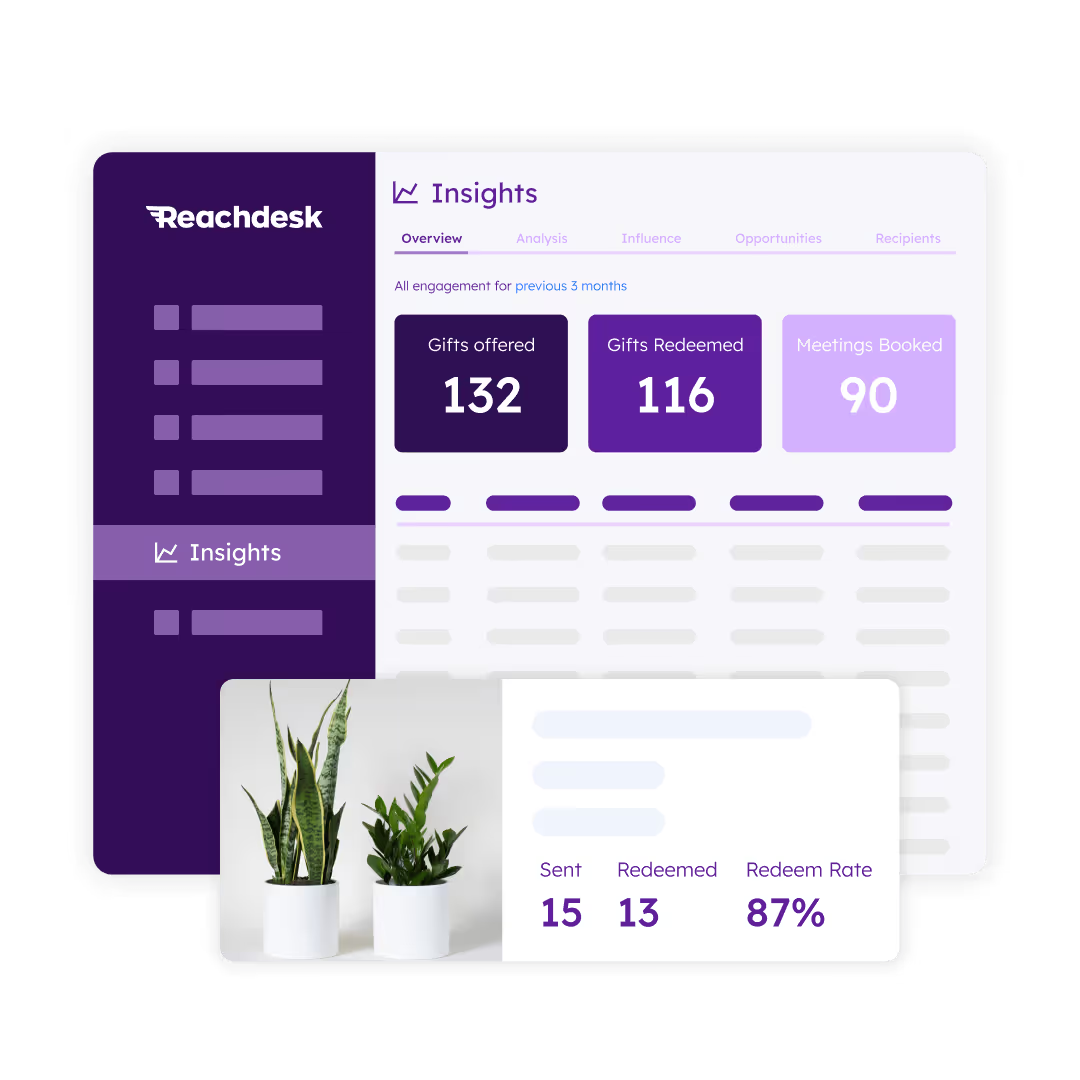
4. Refine your approach based on real data
Scaling means learning what works and doubling down on it.
Run tests on:
- Gift types: Do your accounts prefer experiential gifts (like spa vouchers) or physical items (like branded swag)?
- Messaging angles: Which pain points or value propositions drive the most responses?
- Timing: When in the sales cycle does gifting have the biggest impact?
- Personalization levels: How much customization do you need to see strong results?
The best ABM marketers segment their campaigns by company size and personalization level (like the tiered approach in the data). They track performance by segment. Why? Because you might find that mid-market accounts respond just as well to semi-personalized campaigns as enterprise accounts do to fully customized ones. That's your scaling sweet spot.

5. Extend ABM beyond new logos
Don't stop at new customer acquisition. Use the same principles for:
- Customer expansion: Target specific accounts for upsells or cross-sells with gifting campaigns that celebrate milestones or product launches.
- Renewal campaigns: Send thoughtful gifts before renewal dates to reinforce the relationship and prevent churn.
- Advocacy building: Turn your best customers into champions with thank-you gifts and VIP experiences.
Get started by creating a "customer ABM" program that mirrors your prospect program. Identify your top 25 expansion opportunities and run coordinated campaigns. The ROI on existing customers is often higher because you're starting from trust, not cold outreach.
ABM gifting best practices: What separates good campaigns from great ones
You can send gifts. Or you can send gifts that people remember, talk about, and act on. Here's the difference.
When done well, ABM campaigns that include gifting see 49% engagement from executive sponsors, a 447% increase in opportunities generated, and 70% of recipients taking an online action after receiving a gift. This is proof that the right gift at the right time builds relationships and drives revenue.
Relevance beats budget every time
A $20 gift that shows you understand someone's world beats a $200 generic gift basket every time.
Ask yourself:
- What does this person actually care about?
- What problem are they trying to solve right now?
- What would make their day better?
If you're targeting a VP of Sales heading into Q4, send something that helps them close deals (like a book on negotiation tactics). If you're targeting a CFO, send something that acknowledges their world (like a premium coffee subscription to fuel their budget planning sessions).
Top tip: Look at your target's LinkedIn profile before selecting a gift. Do they post about running? Send running gear. Do they share coffee memes? Send specialty coffee. Do they talk about work-life balance? Send something for their family. Personalization is research, not guesswork.
Timing creates urgency
The best gift at the wrong time is just noise. The right gift at the right time is unforgettable.
Strategic timing examples:
- Pre-meeting gifts: Send a coffee voucher 48 hours before a scheduled demo to increase show-up rates
- Milestone gifts: Send congratulations when they hit a company milestone (funding, award, product launch)
- Re-engagement gifts: Send a "we miss you" gift when an opportunity goes dark for 30+ days
- Holiday gifts: Stand out during gifting season by sending early (October instead of December) or choosing unexpected holidays
Do this by setting up CRM triggers that alert you when it's time to send a gift based on account activity or milestones. Automate the reminder, personalize the selection.
Quality signals intent
Your gift is a reflection of how much you value the relationship. A cheap, generic gift sends a message: "You're not worth much to me."
Choose gifts that:
- Feel premium without being extravagant
- Reflect your brand values
- Come with thoughtful packaging
- Include a personalized note (always)
Our tip? Test your gifts yourself. If you wouldn't be excited to receive it, don't send it to prospects. Your enthusiasm (or lack of it) comes through.
Make gifting part of the conversation, not the whole conversation
A gift without context is just a transaction. A gift that advances a conversation is a strategy.
Your gift should:
- Connect to your message: "I'm sending this because..." not just "Here's a gift"
- Create a natural follow-up: "Enjoy this coffee while you review the proposal I'm sending tomorrow"
- Reinforce your value: Choose gifts that subtly tie back to what you do or the problem you solve
We recommend writing your gift note like you'd talk to a colleague, not like a marketing email. Keep it short, personal, and human. "Hi Sarah, I saw you posted about needing more coffee to survive Q4 planning. Here's a small reinforcement. Looking forward to our call next week. - Alex"
Want to see how other brands are using gifting in their ABM and ABX programs?
Download our free guide to account-based experience and gifting, packed with actionable tips, ideas, and campaigns you can launch today.
Start building your ABM program today
Here's the truth: ABM isn't complicated. It's just focused. You identify the accounts that matter most. You build campaigns specifically for them. You show up consistently across multiple channels. And you use gifting to break through in ways that emails and ads simply can't.
The companies winning with ABM right now aren't waiting for perfect. They're starting with 10-25 accounts, testing what works, and scaling from there.
Your ABM launch checklist:
[ ] Identify your top 25 target accounts based on revenue potential and fit
[ ] Align your sales and marketing teams on account lists and shared KPIs
[ ] Build simple account plans with key contacts and engagement strategies
[ ] Choose 3-4 channels for outreach (email, LinkedIn, content, gifting)
[ ] Launch one gifting campaign to test impact and measure results
[ ] Set up tracking for account engagement, meetings booked, and pipeline influenced
[ ] Review results after 30 days and refine your approach
[ ] Scale to Tier 2 accounts once you've proven the model
Ready to make gifting a core part of your ABM strategy?
Reachdesk makes it easy to send personalized gifts at scale, integrate with your existing tools, and measure the impact on your pipeline. Chat with our team and see why 84% of B2B teams now invest in corporate gifting platforms.
Because in a world where everyone is shouting into inboxes, the teams that win are the ones that show up differently. And nothing says "you matter to us" quite like a thoughtful gift at exactly the right moment.


